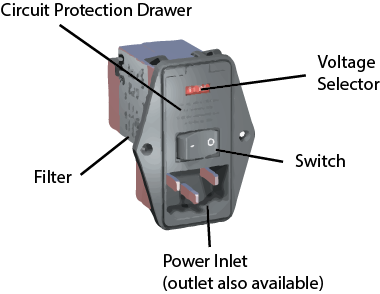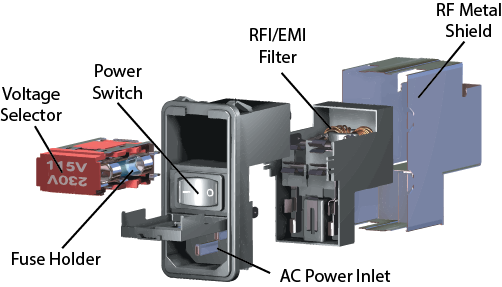Determining Circuit Protection Within a Module
In designing electronic equipment, simplifying the power entry element can make the assembly easier and can benefit a company in the product design.
A module is a device that combines multiple power entry functions into a single unit. Even though these functions are available as individual components, the advantages of a module include user safety, reduced individual component inventory, decreased assembly labor, and saving panel space.
When selecting a module, the desired functions need to be determined. A module may have from two to five functions.
 |
| Possible combinations include: An IEC 60320 inlet or outlet, a switch, circuit protection, a filter, and a voltage selector. |
 |
| An example of a multi-function power entry module. |
Circuit Protection in the Module
“The purpose of offering circuit protection in the module is to provide the customer with a single package that includes as many components as possible that the customer needs for the power entry portion of their system,” explained Dan Ford, Technical Support Specialist at Interpower. “If a module did not offer circuit protection, the customer would still have to source separate circuit protection components and install them individually. By sourcing in one package, they reduce parts ordered, save space, and reduce assembly and interconnection time in some cases.”
Fuses and Circuit Breakers
When a product is being designed for multiple markets, a fuse has an advantage over a circuit breaker in that it’s more cost effective and it’s easier to modify. “Fuses are less expensive than circuit breakers. In addition, this allows the customer to change the size of the fuse to match the application, resulting in them being able to use the single module in multiple applications. Circuit breakers installed in modules can limit them to certain applications, based on the size/rating of the breaker. Fuses also have different clearing characteristics (fast-acting, slow blow, etc.) that allow the equipment manufacturer to fine tune for their applications. This would not be possible with a pre-installed circuit breaker,” Ford said.
For example, a North American product operating at 115VAC might be protected with a 6A fuse. Should that same product also be shipped to an international market, it may run on 230VAC with a 3A fuse. To easily accommodate the differences, if the product has a fuse holder that is compatible with both North American and international fuses, the change can be made smoothly between markets.
Fuse holders and carriers are commonly built into modules so the fuses can be installed to provide circuit protection against abnormal surges and overloads. But it’s important to note that modules do not come with fuses in them. They must be ordered separately. Ford explained why: “Fuses cannot be included in modules for liability reasons. As a supplier of components, we do not have intimate knowledge of what any individual customer’s needs are for their application. If we arbitrarily supplied a certain fuse, and it was the wrong one for a customer’s needs, it could cause damage to the equipment if it was too big to clear a fault. It is the equipment manufacturer’s responsibility to determine the best fuse for their application and order it for optimal performance.”
Fuse Sizes
Fuses come in two different sizes. In North America, the standard size is ¼ʺ x 1¼ʺ while the common size in international markets is 5 x 20mm. The smaller international fuse is starting to become more prevalent in North America.
“Some fused modules can only accept one of the two standard fuse sizes (5 x 20mm or ¼ʺ x 1¼ʺ), while others can accept either, so it is important to review the specification to see what size is needed,” Ford explained. “It should also be noted that the rating of the module (for example, 6A) is the maximum rating of a fuse that should be selected. The amp ratings of modules are dictated by the lowest rating of all the components in a module. Some modules with filters may have a component limiting them to say, 6A. Therefore, fuses should be 6A or smaller. Trying to run a larger fuse, say 10A, in one of these modules can damage the modules and lead to failures.”
Select models allow a change from a single to a double-fused module by removing the fuse substitution clip. In a single-fused module, the clip needs to be positioned on the neutral side of the circuit for the module to work.
Fuses also have different breaking characteristics. North American fuses can be described as “fast-acting” and “time-delay.” For international fuses, these designations include: “quick-acting/low-breaking,” “time-lag/low-breaking,” and “quick-acting/high-breaking.”
Fuse Characteristics
To briefly explain the different characteristics:
Fast-Acting
The fuse will blow quickly when a circuit overloads. It offers protection for equipment that cannot withstand current overloads, even briefly.
Time-Delay
The fuse is designed to withstand some current overload for a limited amount of time. It is used in equipment that can sustain a brief overload situation.
Quick-Acting
Similar to fast-acting, this fuse blows very quickly when overloaded.
Time-Lag
Similar to time-delay, the fuse allows the overload to exist briefly before blowing.
Low-Breaking Capacity
A minimal ability of the fuse to remain physically intact when overloaded. A low-breaking capacity fuse is readily subject to being physically destroyed if the current surge is great enough.
High-Breaking Capacity
A high level of ability of the fuse to remain physically intact even when the overload is great. The fuse is usually constructed with a ceramic body, rather than glass, and filled with silica sand to absorb a large overload and protect the fuse itself.
Additional Resources
For more information to determine which kind of module is best for a specific product design, contact Customer Service. See the complete line of modules and fuses and fuse holders available at Interpower. See also the modules highlighted on the Featured Product page.
Interpower offers free technical support. For further assistance, please see Interpower’s contact information below.





